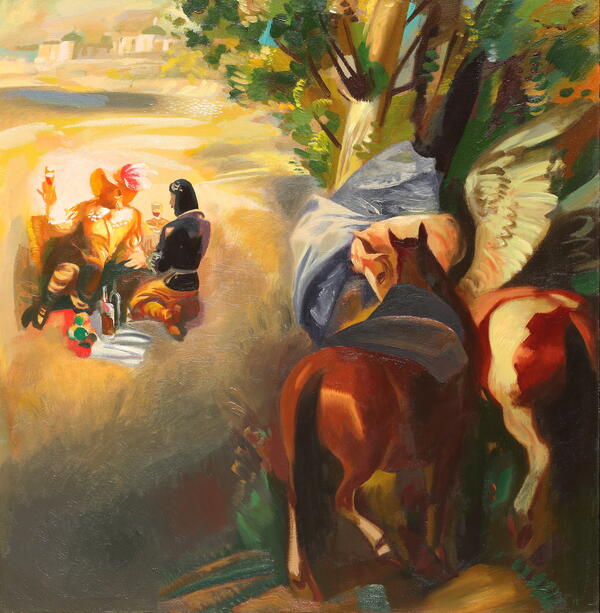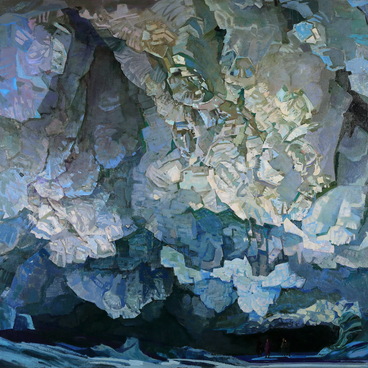Vladimir Alekseyevich Chursin was a muralist and painter that created numerous designer works, including murals, mosaics, and etchings. He painted in the genres of portrait, nude, landscape, and still life. He created unique and peculiar images, combining characters from different cultures, eras, and works of art.
Chursin’s painting “Rubens Visiting Velázquez”, despite being based on some historical evidence, is still mostly the work of the artist’s imagination. Two people are talking and sitting in a sunlit clearing in the distance. In them, the great masters of the 17th century are easily recognized — the Flemish painter Peter Paul Rubens and the Spanish painter Diego Velázquez. The situation is not entirely fictional: the painters did meet in real life.
The death of Isabella Brant, Rubens’ first wife, in 1626 shook the artist to the core. Rubens dealt with the grieving process by taking on important diplomatic tasks: he agreed to participate in the conclusion of peace between England and Spain, as well as the negotiations between Holland and the Southern Netherlands.
As part of one of the diplomatic missions in 1628, Rubens went to Madrid to the court of the Spanish king Philip IV, where he was introduced to the court painter Diego Velázquez. The artists spent a lot of time together. They often went for walks in the picturesque surroundings of Madrid.
Velázquez let Rubens use his workshop in the Royal Alcázar of Madrid so that he could paint undisturbed. In total, Rubens’ stay in Spain lasted eight months. During that time, he painted many portraits of the entourage of the Spanish court and royalty. Following Rubens’ advice, Velázquez went to Italy to study painting. His style was eventually influenced by both the Italian and Flemish schools of painting, which is evident from such paintings as “The Triumph of Bacchus” and “Apollo in the Forge of Vulcan”.
Vladimir Chursin depicted artists resting against the backdrop of a peaceful, idyllic landscape. They sit in a picturesque meadow, talking peacefully and holding glasses in their hands. Their horses graze nearby.
Chursin’s painting “Rubens Visiting Velázquez”, despite being based on some historical evidence, is still mostly the work of the artist’s imagination. Two people are talking and sitting in a sunlit clearing in the distance. In them, the great masters of the 17th century are easily recognized — the Flemish painter Peter Paul Rubens and the Spanish painter Diego Velázquez. The situation is not entirely fictional: the painters did meet in real life.
The death of Isabella Brant, Rubens’ first wife, in 1626 shook the artist to the core. Rubens dealt with the grieving process by taking on important diplomatic tasks: he agreed to participate in the conclusion of peace between England and Spain, as well as the negotiations between Holland and the Southern Netherlands.
As part of one of the diplomatic missions in 1628, Rubens went to Madrid to the court of the Spanish king Philip IV, where he was introduced to the court painter Diego Velázquez. The artists spent a lot of time together. They often went for walks in the picturesque surroundings of Madrid.
Velázquez let Rubens use his workshop in the Royal Alcázar of Madrid so that he could paint undisturbed. In total, Rubens’ stay in Spain lasted eight months. During that time, he painted many portraits of the entourage of the Spanish court and royalty. Following Rubens’ advice, Velázquez went to Italy to study painting. His style was eventually influenced by both the Italian and Flemish schools of painting, which is evident from such paintings as “The Triumph of Bacchus” and “Apollo in the Forge of Vulcan”.
Vladimir Chursin depicted artists resting against the backdrop of a peaceful, idyllic landscape. They sit in a picturesque meadow, talking peacefully and holding glasses in their hands. Their horses graze nearby.





